
Teti, less commonly known as Othoes, sometimes also Tata, Atat, or Athath in outdated sources, was the first pharaoh of the Sixth dynasty of Egypt. He is buried at Saqqara. The exact length of his reign has been destroyed on the Turin King List but is believed to have been about 12 years.
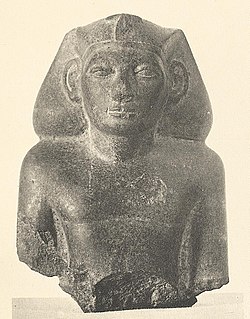
Userkare Khendjer was the twenty-first pharaoh of the Thirteenth Dynasty of Egypt during the Second Intermediate Period. Khendjer possibly reigned for 4 to 5 years, archaeological attestations show that he was on the throne for at least 3 or 4 years 3 months and 5 days. Several absolute dates have been proposed for his reign, depending on the scholar: 1764—1759 BC as proposed by Ryholt and Baker, 1756—1751 BC as reported by Redford, and 1718—1712 BC as per Schneider. Khendjer had a small pyramid built for himself in Saqqara and it is therefore likely that his capital was in Memphis.
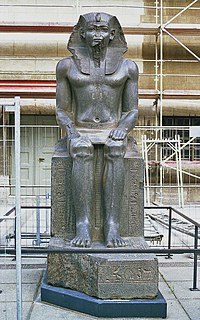
Nubkaure Amenemhat II was the third pharaoh of the 12th Dynasty of ancient Egypt. Although he ruled for at least 35 years, his reign is rather obscure, as well as his family relationships.
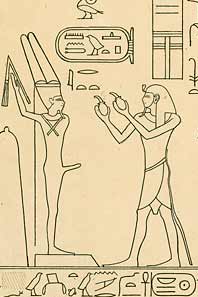
Nebtawyre Mentuhotep IV was the last king of the 11th Dynasty. He seems to fit into a 7-year period in the Turin Canon for which there is no recorded king.
Ptahhotep, sometimes known as Ptahhotep I or Ptahhotpe, was an ancient Egyptian vizier during the late 25th century BC and early 24th century BC Fifth Dynasty of Egypt.

Sekhemib-Perenma'at, is the horus name of an early Egyptian king who ruled during the 2nd dynasty. Similar to his predecessor, successor or co-ruler Seth-Peribsen, Sekhemib is contemporarily well attested in archaeological records, but he does not appear in any posthumous document. The exact length of his reign is unknown and his burial site has yet to be found.
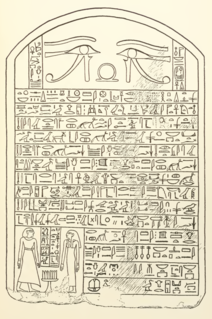
Wahibre Ibiau was an ancient Egyptian pharaoh of the 13th Dynasty, who reigned c. 1670 BC for 10 years 8 months and 29 days according to the Turin King List.

Ameny Qemau was an Egyptian pharaoh of the 13th Dynasty during the Second Intermediate Period. According to Egyptologists Kim Ryholt and Darrell Baker, he was the 5th king of the dynasty, reigning for 2 years over most of Egypt, except perhaps the eastern Nile Delta, from 1793 BC until 1791 BC.

Neferkauhor Khuwihapi was an ancient Egyptian pharaoh of the Eighth Dynasty during the early First Intermediate Period, at a time when Egypt was possibly divided between several polities. Neferkauhor was the sixteenth and penultimate king of the Eighth Dynasty and as such would have ruled over the Memphite region. Neferkauhor reigned for little over 2 years and is one of the best attested kings of this period with eight of his decrees surviving in fragmentary condition to this day.

Ankhesenpepi II or Ankhesenmeryre II was a queen consort during the sixth dynasty of Egypt. She was the wife of Kings Pepi I and Merenre Nemtyemsaf I, and the mother of Pepi II. She was buried in a pyramid in Saqqara.

Bebi was an Egyptian vizier under king Mentuhotep II in the Eleventh Dynasty. He is known only from a relief fragment found in the mortuary temple of the king at Deir el-Bahari. The fragment is now in the British Museum. The short caption to the figure of Bebi reads: vizier, zab-official, the one belonging to the curtain Bebi. Bebi might have been the first Middle Kingdom official with that title. His successor was Dagi. Perhaps Bebi started his career as treasurer: indeed, a treasurer with the name Bebi is known from the stela of a minor official called Maati, now in the Metropolitan Museum of Art, New York.
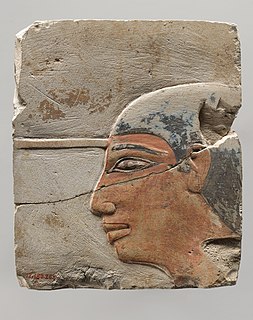
Dagi was an ancient Egyptian vizier during the reign of pharaoh Mentuhotep II of the Eleventh Dynasty.

Seankhibre Ameny Antef Amenemhet VI was an Egyptian pharaoh of the early Thirteenth Dynasty ruling in the first half of the 18th century BC during a time referred to as the late Middle Kingdom or early Second Intermediate Period, depending on the scholar. Amenemhat VI certainly enjoyed a short reign, estimated at 3 years or shorter. He is attested by a few contemporary artefacts and is listed on two different king lists. He may belong to a larger family of pharaohs including Amenemhat V, Ameny Qemau, Hotepibre Qemau Siharnedjheritef and Iufni.
Sobekemhat was an Ancient Egyptian treasurer under the king Senusret III in the Twelfth Dynasty. Sobekemhat is only known from his mastaba excavated in 1894 next to the pyramid of Senusret III at Dahshur. The mastaba was decorated on the outside with reliefs. These were only found in small fragments, but the fragments record the name and the titles of Sobekemhat. On an offering table he bears the title of the treasurer. The mastaba is in a chain of three mastabas, north of the king's pyramid. It is closest to the pyramid. The next mastaba belongs to the vizier (Nebit) and the third to another high official, perhaps again a vizier. Therefore, it can be argued that Sobekemhat's tomb was the earliest of the three. For a long time it was thought that Sobekemhat was vizier, but the relief fragments with the vizier's title come from the mastaba of Nebit nearby.
Betrest was a royal queen of Ancient Egypt. She lived during the First Dynasty.
Kheti was an Ancient Egyptian vizier of the Twelfth Dynasty under king Amenemhet III, around 1800 BC. Kheti is known from a papyrus fragment dated to year 29 of that king. He is the only vizier who can be specifically dated to the rule of Amenemhat III. In the Installation of the Vizier, a text referring to the office of the vizier, found in several New Kingdom tombs, there is mentioned a famous vizier named Kheti. About him is said: He impoverished his associates for the benefits of others. It seems possible that both sources refer to the same person.
Nebit was an Ancient Egyptian official during the reign of king Senusret III. He held the position of vizier. Thus he was the most important official at the royal court. Nebit is only known from his large mastaba which was excavated next to the pyramid of the king at Dahshur. The mastaba was built of mud bricks and then covered with stones. Already in ancient times the high quality stone was looted and used for other building projects or just for burning lime. However, one wall of the mastaba facade had already collapsed and had been covered by sand before looters dismantled the rest of the building. The preserved facade bears the name and title of Nebit, but also the name of the king. Within the remains of the mastaba were found by Jacques de Morgan the bust of a statue made of granodiorite. The fragment is not inscribed but most likely depicts Nebit.
Iufni was an Ancient Egyptian pharaoh of the 13th Dynasty during the Second Intermediate Period. According to the egyptologists Kim Ryholt and Darrell Baker he was the 7th king of the dynasty, while Jürgen von Beckerath and Detlef Franke see him as the 6th ruler. Iufni reigned from Memphis for a very short time c. 1788 BC or 1741 BC.

Several fragments belonging to Annals of Amenemhat II are known from Memphis in Egypt. They are an important historical document for the reign of the Ancient Egyptian king Amenemhat II, but also for the history of Ancient Egypt and understanding kingship in general.

Hatshepsut was an Ancient Egyptian king's daughter of the 13th Dynasty, around 1750 BC. There are three instances where a person named Hatshepsut is mentioned. It is not known if these are the same or different individuals.